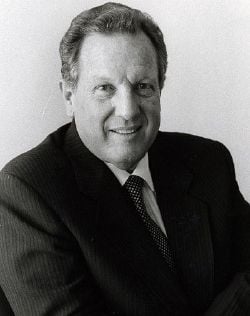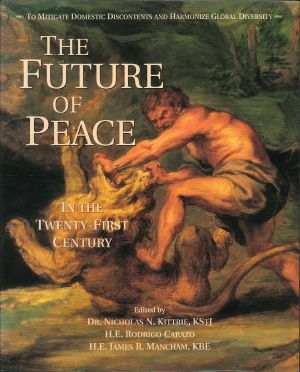Rodrigo Carazo Odio
| Rodrigo Carazo Odio | |

| |
38th President of Costa Rica
| |
| In office May 8, 1978 – May 8, 1982 | |
| Vice President(s) | Rodrigo Altmann Ortiz José Miguel Alfaro Rodríguez |
|---|---|
| Preceded by | Daniel Oduber Quirós |
| Succeeded by | Luis Alberto Monge Álvarez |
| Born | December 27 1926 Cartago, Costa Rica |
| Died | December 9 2009 (aged 82) San José, Costa Rica |
| Political party | Unity Coalition (Current Social Christian Unity Party) |
| Spouse | Estrella Zeledón Lizano (m. 1947–2009; his death) |
| Signature | |
Rodrigo José Ramón Francisco de Jesús Carazo Odio (December 27, 1926 – December 9, 2009) served as President of Costa Rica from May 8, 1978 to May 8, 1982.[1]
Early life
Rodrigo Carazo was born in Cartago, Costa Rica.
He married Estrella Zeledón Lizano in San José on April 16, 1947. The couple had five children: Rodrigo Alberto, Mario Ernesto, Jorge Manuel, Álvaro, and Rolando Martin.[2] Their son, Rolando, was killed in a motorcycle accident in Rohrmoser, Costa Rica, in December 1979.[2] He was traveling alone on his motorcycle when he failed to negotiate a turn losing control and colliding with a tree. He was 26 years old.
Career
Carazo served as the Director of the Central Bank, General Manager for RECOPE (Costa Rica's nationalized oil refinery business) and President of the Legislative Assembly of Costa Rica (1966-1967).[3]
Presidency
During and immediately following his term, Carazo played a central role in the founding of the University for Peace, a United Nations-affiliated educational institution that offers graduate programs in peace and development studies. His government also concentrated on and promoted the country's petrochemical industry and even began exploration and digging near the Talamanca Mountain Ridge in search for petroleum. In the energy sector, his government inaugurated the hydroelectric plant in Lake Arenal. The Carazo government also regulated the excavation of gold in the southern region of the country.
On the international front, Carazo had to deal mainly with the radical changes in the neighboring country of Nicaragua, which had been under the control of the Somoza dictatorship for decades, whose rule Costa Rica had always opposed. As the Sandinista movement rose in the 1970s, Nicaragua was faced with civil unrest and small armed clashes. Costa Rica's government supported any power against Somoza and so backed backing to the Sandinista insurgents. Many of the battles that took place in the Nicaraguan region bordering Costa Rica spilled onto Costa Rican soil. Carazo's government warned Somoza to stay on his side of the border several times.
The government also began plans on creating a defense force to fight off any Somoza attempt to attack Costa Rican territory. The attacks finally ended in 1979 once the Sandinistas took control of the country, and Somoza was exiled. The government received a strong backlash from the public, and the opposition claimed that Carazo had failed to protect Costa Rica's sovereignty. Further, Carazo's government allowed three US helicopters to touch down on national soil to facilitate Somoza's escape from Nicaragua. That sent the President's critics on a political bashing rampage, calling the matter a disrespect to national sovereignty. Later, in 1982, the Central American Democratic Community was formed in San José with US backing. Its aim was to isolate Nicaragua from the rest of Central America as long as they had a Communist regime in power. Another big move was in 1981, when Carazo's government broke off all diplomatic ties with Fidel Castro's Cuba.
Carazo's government was plagued by economic instability and social unrest. During his presidency, there was a world economic recession. Petroleum prices were at historic highs, and the value of Costa Rica's main crop, coffee, was falling. Against the advice of his Minister of Finance, Hernán Sáenz Jiménez, and the International Monetary Fund (IMF), Carazo instructed the Central Bank of Costa Rica to borrow heavily to maintain the value of the colón, the local currency, in the hope that an economic recovery was close at hand. That policy eventually became unsustainable, leading to a catastrophic sudden devaluation in September 1980. The heavy load of debt that the central bank acquired contributed to the highest rates of inflation that Costa Rica has endured ever since.
After stepping down as president in 1982, Carazo became a well-known critic of the IMF and other global financial institutions. In his last years, he campaigned vigorously against the Central American Free Trade Agreement (CAFTA).
Later life
Carazo played a leadership role in initiatives to improve relations between North Korea and the West. He made several visits to Pyongyang in the early 1990s. His efforts contributed to the opening of unofficial channels of communication between the United States and North Korea.
At the time of the 100th anniversary of the awarding of the first Nobel Peace Prize, together with colleagues Nicholas N. Kitrie, American legal scholar and chair of the Eleanor Roosevelt Institute for Justice and Peace, and Sir James Mancham, the founding president of Seychelles, he created a major work entitled The Future of Peace in the Twenty-First Century. The subtitle of this book, "to mitigate domestic discontents and harmonize global diversity" encapsulated his focus on dissidents expanded to the international level together with the need to find harmony among diverse cultures in order to create a world of peace.[4]
Carazo was the founding Chairman of University for Peace and United World Colleges Costa Rica.
Carazo died from heart failure and multi-organ failure at the Hospital México in San José on December 9, 2009, at the age of 82.[2] He was survived by his wife, former First Lady Estrella Zeledón Lizano, and four of their five children: Rodrigo Alberto, Mario Ernesto, Jorge Manuel and Álvaro.[2]
Notes
- ↑ Presidentes de la República de Costa Rica Infohistoria. Retrieved June 27, 2023.
- ↑ 2.0 2.1 2.2 2.3 Loaiza, Vanessa, "Falla en tres órganos causó muerte a expresidente Carazo", La Nación (San José), 2009-12-09.
- ↑ Legislative Assembly Official website
- ↑ Nicholas N. Kittrie, Rodrigo Carazo, and James Mancham (eds.), The Future of Peace in the Twenty-First Century (Carolina Academic Press, 2003, ISBN 978-0890892114).
ReferencesISBN links support NWE through referral fees
- Castillo Mendez, Mario. Rodrigo Carazo Con La Dignidad En Las Venas. Ediciones El Castillo, 2002. ASIN B00ZG25Z3E
- Kittrie, Nicholas N., Rodrigo Carazo, and James Mancham (eds.). The Future of Peace in the Twenty-First Century. Carolina Academic Press, 2003. ISBN 978-0890892114
- Carazo, Rodrigo. Carazo: Tiempo y marcha. Editorial Universidad Estatal a Distancia, 1989. ISBN 978-9977644820
External links
All links retrieved June 27, 2023.
- Rodrigo Carazo Odio Asamblea Legislativa República de Costa Rica
- Rodrigo Carazo Odio Biografías y Vidas
- Rodrigo Carazo Odio National Museum of Costa Rica
- Rodrigo Carazo Odio: his reflections on politics, state and public company by Jose Daniel Rodriguez Arrieta Ruptures Magazine 7(1) 2017
- UPEACE History University for Peace
Credits
New World Encyclopedia writers and editors rewrote and completed the Wikipedia article in accordance with New World Encyclopedia standards. This article abides by terms of the Creative Commons CC-by-sa 3.0 License (CC-by-sa), which may be used and disseminated with proper attribution. Credit is due under the terms of this license that can reference both the New World Encyclopedia contributors and the selfless volunteer contributors of the Wikimedia Foundation. To cite this article click here for a list of acceptable citing formats.The history of earlier contributions by wikipedians is accessible to researchers here:
The history of this article since it was imported to New World Encyclopedia:
Note: Some restrictions may apply to use of individual images which are separately licensed.
